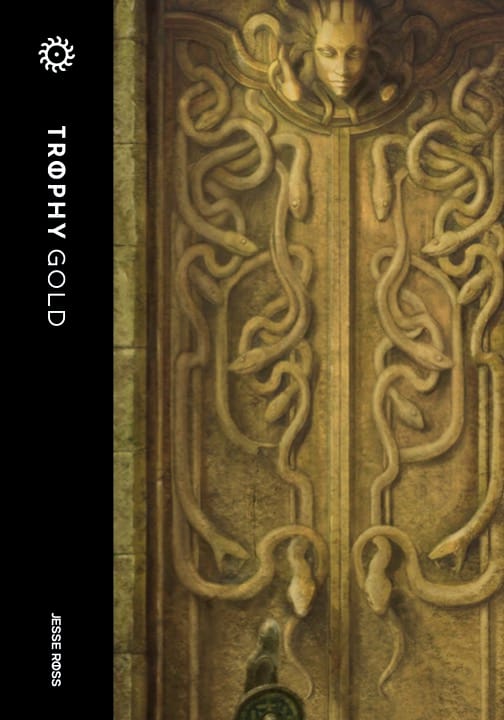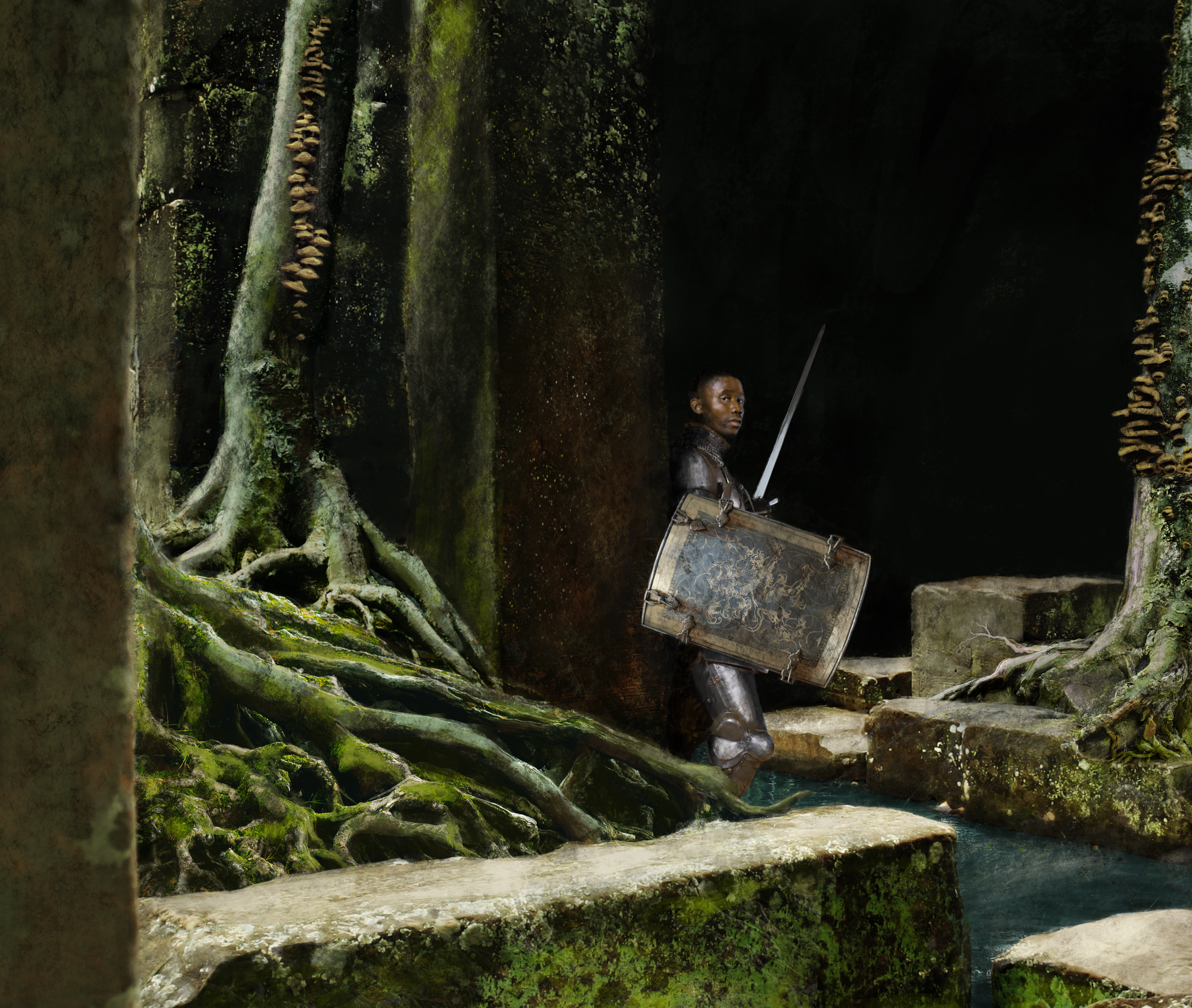
Trophy Gold is an absolute mess of a game, and my favourite innovation in elfgame dungeon-crawling ever. A fork of Trophy Dark by Jesse Ross, they’re both beautiful, cloth-bound tomes, released together alongside Trophy Loom, a setting supplement for them both.
Trophy Dark focuses on the perspective that if you put a group of people into the mythic underworld, they’d soon betray each other and meet tragic ends. In Dark, it’s a forest and your doom is inevitable. Your character sheet in Dark is a list of things that you can use to impact the dice rolls that make up the game’s mechanics, things like skills, rituals and conditions, with a death tracker called ruin attached to them.
The Risk Roll is the main mechanic in Dark, rolling a pool of dice to find out what happens when you attempt something risky. “Say what you hope will happen, and ask the GM and the other players what could possibly go wrong” is key: We’re shared story-tellers. There are rolls for helping, contests, suffering ruin and betraying your fellow treasure-hunters. But the more important rules in Dark than the procedural rules are the directive rules (this distinction first made by Chris Chinn): “Embrace tragedy, don’t hold back, play to lose”. Dark expects these directives to guide the few procedures, not the other way around.
Dark is an interesting perspective on dungeon-crawling, fun to use as a one-shot of doomed adventurers, but most players like getting to know their characters in campaign play: Enter Trophy Gold, an attempt to solve this problem. Gold is quite explicit in its intent to “blend… with the survive-by-your-wits mentality of old school fantasy games”.
Gold does this by adding new procedures. Burden (ongoing costs-of-living) gold, horde, downtime and advancement. The Hunt Roll drives gameplay now, whenever “you press ever deeper in pursuit of a specific and immediate goal”, you earn Hunt Tokens which you can exchange for gold or to achieve goals. There is a new combat roll, but ruin and betrayal rolls are gone. The directives are “Be curious, play to win, play to lose”, which are more interesting in the way they hold tension, and capture traditional themes succinctly. Downtime is prompt-stuffed and cosy. The bestiary records each unique monster, giving you advantages when faced again.

Do all these additions in Gold work as a solution to the problem of Dark’s doomed explorers? No, it’s a mess. But it’s a compelling mess, and much more compelling than Dark. The bestiary ends up disregarded, because you’re unlikely to encounter a monster twice. Worse, there is no list of example monsters in the book, although the strong of heart can wade through said incursions to find some.
The best source for information on how to play should be the book itself, not discord and the Gauntlet forums. Combat is an absolute train wreck; not because the rules don’t work, but rather because they’re just so poorly written I’ve had people familiar with Pathfinder 2 ask me why Trophy Gold is so complicated. The Risk Roll is still the most important roll, even though it says it’s not, but the Hunt Roll provides Hunt Tokens, which are necessary metacurrency for gaining enough gold to survive. The Hunt Roll only provides new information and so disincentivises exploration compared to Dark. Downtime relies on the new deadly currencies to function, and so disincentivises use.
Thematically, it’s trying to say something about the endless cycle of capitalism resulting in obsessive treasure-seeking, but the theme isn’t communicated in a way that is fun. Gold leans much more heavily on its directives than Dark does, because its procedures are all carrot and no stick. The tension between ongoing fantasy campaign play and the doomed horror of Dark is not one that is adequately resolved in the Gold ruleset.
Incursions are what the Trophy games call their adventure modules. Each location has a list of props, moments, and traps, and treasures that aren’t necessarily tied to anything but the set’s theme, making each location cohesive, but driven by the results of Hunt and Risk Rolls. Locations are organised by flowchart, not spatially. This is damned elegant, and rules flex around set structure pleasingly. However, this tight relationship between Hunt, Risk and Incursion makes me reluctant to play adventures not designed for Gold. I suspect Roots of Old Kalduhr, taking up 100 pages, is meant to prove you can run something like Gold promises you can, but the rules themselves don’t evidence it well.
Both Dark and Gold are filled with pages of evocative, random tables (you may randomly generate a “beastbitten labourer seeking to locate the jewel that haunt’s Eriol’s dreams”). This is evocative, player-lead worldbuilding, and is a great strength of Dark and Gold. Trophy Loom then is filled with explanations for what these things mean. Because of this, it’s hard to recommend Loom in the context of the other books: It actually acts at cross purposes to the core texts.
The word count on some of Loom’s topics is so high it seems contrary to Trophy’s remit elsewhere, The quality of the writing in Loom is excellent, although over-written and therefore challenging at the table, with a few highlights in terms of usability (“Treasures”, “Monsters of the Wood”, “Blasphemous Cults”). If it leaned harder into being filled with things to drop directly into your incursions, building the world that way and less traditionally, I think it would be a better book.
Would I recommend these three books? To various degrees. Gold belongs on my bookshelf, despite my clearly mixed feelings about the ruleset. I’ll keep playing it for a long time, but there’s a version of Trophy Gold that handles the tensions in a more elegant way. Trophy Dark is a game I’ll play as a one-shot, occasionally. It’s much better than Trophy Gold, but at something I don’t care to play regularly. Trophy Loom though is not something I’ll ever use, but your mileage may vary, depending on your dedication to the world of Trophy and your inclination to share worldbuilding with your players.
Writing & Art: Jesse Ross
Published by The Gauntlet
This feature originally appeared in Wyrd Science Vol.1, Issue 5 (Dec '23)
